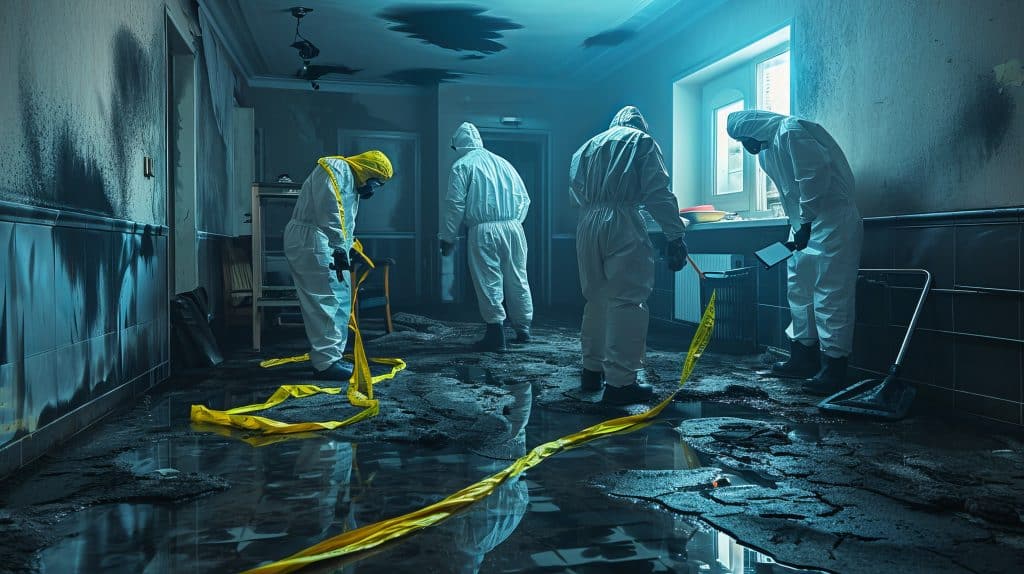Have you ever wondered what happens to a crime scene after the police tape comes down? The horrifying aftermath often involves blood, bodily fluids, and other biohazards. This is where crime scene cleanup professionals step in.
This blog post will explore the intricacies of the process, the challenges faced by cleanup technicians, and the vital role they play in restoring dignity to crime scenes.
What Is Crime Scene Cleanup?
Crime scene cleanup, also known as biohazard remediation, is the process of cleaning and decontaminating areas where a traumatic event, such as a crime, accident, or unattended death, has occurred.
This specialized service provides safe and discreet crime scene cleanup, crucial for removing biohazardous materials, such as blood, bodily fluids, and other potentially infectious substances, to restore the space to a safe, livable condition.

 Crime Scene Cleanup Process
Crime Scene Cleanup Process
The crime scene cleaning process involves carefully managed steps to ensure the area is thoroughly decontaminated and restored to a safe, livable state. Here’s a look at the step-by-step process involved in a thorough crime scene cleanup:
1. Assessment and Planning
The process begins with a detailed assessment of the crime scene. Cleanup professionals thoroughly examine the area to determine the scope and type of contamination present, including blood, bodily fluids, or other biohazardous substances.
This evaluation helps identify the necessary tools, protective gear, and cleaning agents required to address the specific conditions of the scene. Based on the findings, a customized cleanup plan outlines the step-by-step approach to treat every affected area.
This careful planning phase is essential for organizing resources efficiently and setting a clear, manageable path forward.
2. Containment and Safety Precautions
Once the plan is in place, the next priority is containment. This step involves creating physical barriers to isolate the affected area, preventing biohazardous materials from spreading to other parts of the property.
Cleanup technicians wear personal protective equipment (PPE) such as gloves, masks, face shields, and full-body suits to protect against direct exposure to contaminants. Safety is paramount in this field, and the strict use of PPE and containment materials ensures a controlled and secure work environment.
These measures also help minimize cross-contamination risks, preserving the health and safety of the cleanup team and anyone who may later enter the area.
3. Biohazard Removal and Disposal
With safety protocols firmly in place, the actual biohazard removal process begins. Technicians carefully remove all contaminated items, including blood-soaked materials, body fluids, and objects that cannot be thoroughly cleaned.
Carpets, upholstery, and other absorbent surfaces that have come into contact with biohazards are often removed and safely disposed of, following local and federal regulations for hazardous waste.
Proper disposal is a critical component of professional crime scene cleanup, as it helps ensure that all hazardous materials are handled responsibly, preventing potential harm to the environment and community.
4. Cleaning and Decontamination
After removing contaminated items, the affected area undergoes deep cleaning and decontamination. Professionals use hospital-grade cleaning supplies, disinfectants, enzymatic cleaners, and antimicrobial agents to treat all surfaces and eliminate bloodborne pathogens.
In cases where contaminants have seeped into hard-to-reach areas, advanced equipment such as ozone generators or UV-C light devices may be used to sanitize thoroughly.
The goal is to eradicate any lingering bacteria or viruses to reduce the risk of infection or disease transmission. This meticulous cleaning ensures the space is thoroughly decontaminated and ready for safe use.
5. Odor Control and Restoration
Biohazard incidents can leave behind persistent, unpleasant odors that traditional cleaning methods struggle to eliminate. To combat this, professionals employ specialized deodorization techniques. These advanced methods, such as ozone or hydroxyl generation, work at a molecular level to neutralize odors, leaving the area fresh and clean.
These methods are highly effective at removing smells that can linger for extended periods, ensuring the air quality are restored to a fresh and neutral state. Additionally, if any structural or aesthetic damage occurred during the incident, technicians may perform minor restoration work, such as repainting walls or replacing flooring, to return the area to its original condition. This final touch is essential for making the space not only clean but also welcoming and functional.
6. Final Inspection and Clearance
The last step is a comprehensive inspection of the cleaned area to verify that it meets all health and safety standards. Professionals thoroughly check to confirm that all biohazards have been removed, surfaces are sanitized, and any lingering odors are completely eliminated.
External inspectors or regulatory agencies may sometimes be involved, especially for public or commercial spaces, to ensure compliance with strict safety guidelines. This final clearance gives property owners peace of mind, knowing the area is safe for everyday use and that all necessary precautions have been taken to protect future occupants.
Through these carefully managed steps, the crime scene cleaning process provides a respectful, safe, and effective way to restore affected spaces, allowing family members, property owners, and businesses to move forward in a clean and secure environment.
Conclusion
As the final chapter in a tragic story unfolds, crime scene cleaners begin their work. Their role, often unseen and misunderstood, is essential in restoring dignity to spaces marred by violence. By understanding the complexities of their work, you can appreciate the immense dedication and compassion required to heal the wounds left behind.

